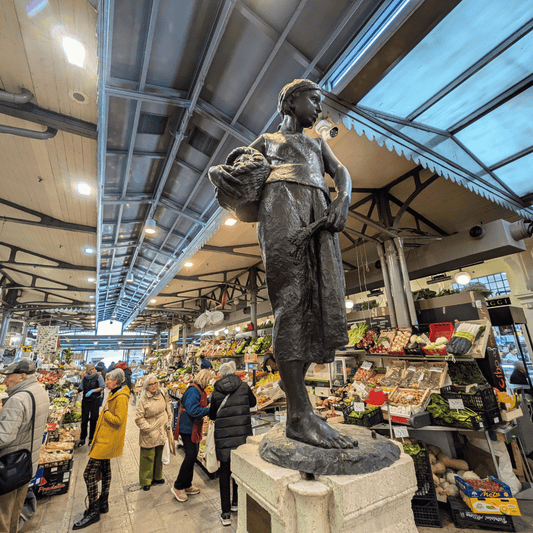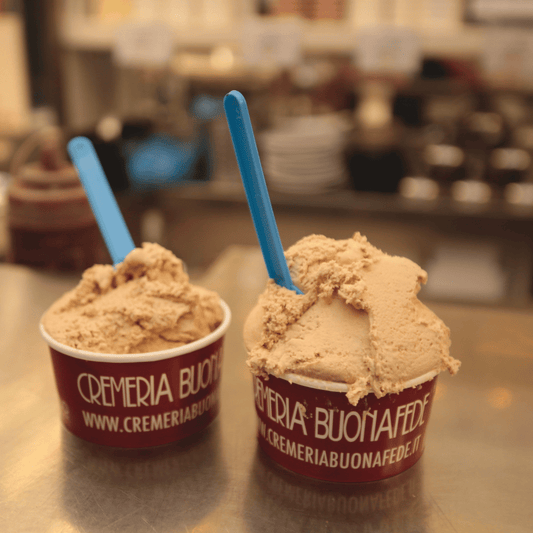Italien ist bekannt für seine reiche und vielfältige Esskultur, die sich je nach Region erheblich unterscheidet. Hier sind die besten Dinge, die man in Italien tun kann: essen. Dies ist also eine Liste dessen, was man auf einer Food-Tour durch Italien essen sollte:
1. Backwaren
- Pane (Brot): Verschiedene Sorten wie Ciabatta, Focaccia und Pane di Altamura.
- Grissini (Brotstangen): Dünne, knusprige Brotstangen, die oft mit Vorspeisen serviert werden.
- Cornetto: Italienisches Croissant, oft mit Marmelade, Sahne oder Schokolade gefüllt.
- Focaccia: Flaches, im Ofen gebackenes Brot, oft mit Olivenöl, Kräutern oder Salz belegt.
- Cantucci: Mandelkekse, typischerweise mit Vin Santo (Süßwein) serviert.
2. Käse
- Parmigiano Reggiano: Hartkäse aus Parma, ein wichtiger Bestandteil vieler italienischer Gerichte.
- Mozzarella di Bufala: Weicher, cremiger Käse aus Kampanien, hergestellt aus Büffelmilch.
- Gorgonzola: Eine Art Blauschimmelkäse aus den nördlichen Regionen Italiens.
- Pecorino: Eine Familie von harten, salzigen Käsesorten aus Schafsmilch.
- Ricotta: Weicher, cremiger Käse, oft in Desserts oder Pastafüllungen verwendet.
3. Frisches Gemüse
- Tomaten: Unverzichtbar in der italienischen Küche, besonders in Soßen (z. B. San Marzano Tomaten).
- Oliven: Werden zum Kochen, als Snack oder zur Herstellung von Olivenöl verwendet.
- Auberginen (Melanzane): Eine wichtige Zutat in Gerichten wie Auberginen-Parmesan.
- Zucchini: Oft gegrillt, gefüllt oder in Pastagerichten verwendet.
- Artischocken: Besonders beliebt in der römischen und Lazio-Küche.
- Fenchel: Häufig in Salaten und als Beilage verwendet.
- Spinat: Wird oft in Pastafüllungen, Risottos und Salaten verwendet.
4. Obst
- Zitrusfrüchte: Orangen, Zitronen und Mandarinen, besonders aus Sizilien und der Amalfiküste.
- Äpfel: Wachsen in den nördlichen Regionen, verwendet in Kuchen und Torten.
- Birnen: Oft in Desserts oder Salaten verwendet.
- Trauben: Wichtig sowohl zum Essen als auch für die Weinherstellung.
- Beeren: Erdbeeren, Himbeeren und Brombeeren in vielen Desserts.
5. Fleisch und Wurstwaren
- Prosciutto di Parma: Luftgetrockneter Schinken, ein Grundnahrungsmittel in vielen italienischen Gerichten.
- Salami: Verschiedene Arten italienischer Salami, darunter Genua- und Milano-Salami.
- Bresaola: Luftgetrocknetes, gesalzenes Rindfleisch aus der Lombardei.
- Würste: Salsiccia, oft in Pastagerichten oder gegrillt verwendet.
- Porchetta: Geröstetes, gewürztes Schweinefleisch, typischerweise als Sandwichfüllung oder bei Festen serviert.
6. Pasta
- Spaghetti: Lange, dünne Nudeln, oft mit tomatenbasierten Soßen serviert.
- Fettuccine: Flache, breite Nudeln, typischerweise mit reichhaltigen Soßen wie Alfredo kombiniert.
- Ravioli: Teigtaschen, gefüllt mit Käse, Fleisch oder Gemüse.
- Lasagne: Geschichtetes Nudelgericht, typischerweise mit Fleischsoße, Béchamel und Käse.
- Penne: Röhrenförmige Pasta, oft mit herzhaften Soßen wie Arrabbiata kombiniert.
7. Olivenöl
- Natives Olivenöl Extra (EVOO): Wird in Salaten, zum Kochen und zum Beträufeln von Pasta, Brot oder Gemüse verwendet.
- Aromatisierte Olivenöle: Oft mit Kräutern wie Basilikum, Knoblauch oder Trüffel versetzt.
8. Meeresfrüchte
- Sardinen: Oft gegrillt oder in Pastagerichten serviert, besonders in der sizilianischen Küche.
- Anchovis: Werden in Soßen, auf Pizza oder als Vorspeise verwendet.
- Calamari: Tintenfisch, oft frittiert oder gegrillt und in Pastagerichten verwendet.
- Branzino: Ein mediterraner Wolfsbarsch, gegrillt oder gebraten.
- Seeigel: Eine Delikatesse, oft in Pasta oder als Belag serviert.
9. Gebäck und Süßigkeiten
- Tiramisu: Ein kaffeearomatisiertes Dessert aus Mascarpone, Löffelbiskuits und Kakao.
- Cannoli: Knusprige Teigrollen, gefüllt mit süßer Ricottacreme, oft mit kandierten Früchten oder Schokostückchen garniert.
- Panna Cotta: Cremiges Dessert, typischerweise mit Beeren oder Karamellsoße serviert.
- Gelato: Italienisches Speiseeis, reichhaltiger und dichter als typisches Eis.
- Panettone: Süßer Brotlaib, der typischerweise zu Weihnachten genossen wird, gefüllt mit Trockenfrüchten oder Schokolade.
10. Kräuter und Gewürze
- Basilikum: Frischer Basilikum ist entscheidend für Pesto und viele mediterrane Gerichte.
- Oregano: Wird häufig in Pizza, Pastasoßen und Bratengerichten verwendet.
- Rosmarin: Oft in Kombination mit Fleisch, besonders Lamm oder Schwein.
- Thymian: Wird in verschiedenen italienischen Eintöpfen und Fleischgerichten verwendet.
- Knoblauch: Eine grundlegende Zutat in der italienischen Küche, verwendet in allem von Pastasoßen bis zu Braten.
11. Getränke
- Wein: Italien ist berühmt für seinen Wein, mit Sorten wie Chianti, Barolo, Prosecco und Pinot Grigio.
- Espresso: Ein kleiner, starker Kaffee, der den ganzen Tag über serviert wird.
- Limoncello: Ein Zitronenlikör von der Amalfiküste, typischerweise gekühlt nach dem Essen serviert.
- Grappa: Ein kräftiger italienischer Branntwein aus Traubentrester.
12. Bohnen und Hülsenfrüchte
- Kichererbsen: Oft in Suppen, Salaten oder Pürees wie Hummus verwendet.
- Linsen: Verwendet in Suppen, Eintöpfen und Salaten.
- Saubohnen: Eine traditionelle Zutat in der römischen Küche.
- Cannellini-Bohnen: Werden in italienischen Suppen und Beilagen verwendet.
Die Esskultur Italiens ist tief in lokalen Traditionen verwurzelt, wobei jede Region unterschiedliche Zutaten und kulinarische Techniken bietet. Von frischen Produkten bis hin zu erstklassigen Käsesorten ist Italiens Essen so vielfältig und reichhaltig wie seine Geschichte.



















